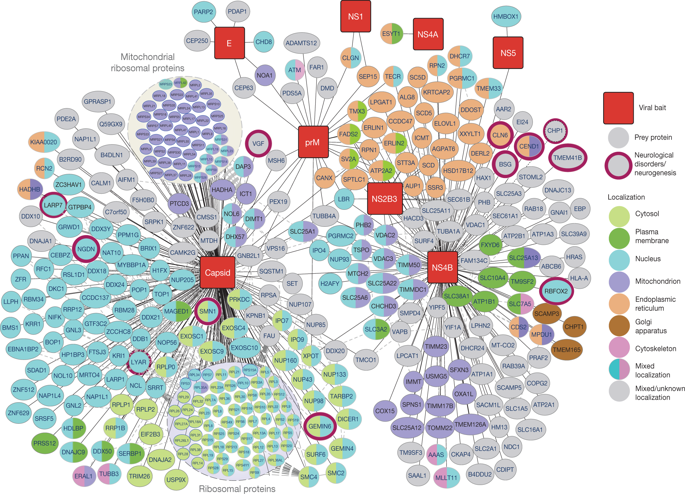Our official English website, www.x-mol.net, welcomes your feedback! (Note: you will need to create a separate account there.)
An orthogonal proteomic survey uncovers novel Zika virus host factors
Nature ( IF 64.8 ) Pub Date : 2018-09-01 , DOI: 10.1038/s41586-018-0484-5 Pietro Scaturro 1, 2 , Alexey Stukalov 1, 2 , Darya A Haas 1 , Mirko Cortese 3 , Kalina Draganova 4, 5 , Anna Płaszczyca 3 , Ralf Bartenschlager 3, 6 , Magdalena Götz 4, 5, 7 , Andreas Pichlmair 1, 2, 8
Nature ( IF 64.8 ) Pub Date : 2018-09-01 , DOI: 10.1038/s41586-018-0484-5 Pietro Scaturro 1, 2 , Alexey Stukalov 1, 2 , Darya A Haas 1 , Mirko Cortese 3 , Kalina Draganova 4, 5 , Anna Płaszczyca 3 , Ralf Bartenschlager 3, 6 , Magdalena Götz 4, 5, 7 , Andreas Pichlmair 1, 2, 8
Affiliation

|
Zika virus (ZIKV) has recently emerged as a global health concern owing to its widespread diffusion and its association with severe neurological symptoms and microcephaly in newborns1. However, the molecular mechanisms that are responsible for the pathogenicity of ZIKV remain largely unknown. Here we use human neural progenitor cells and the neuronal cell line SK-N-BE2 in an integrated proteomics approach to characterize the cellular responses to viral infection at the proteome and phosphoproteome level, and use affinity proteomics to identify cellular targets of ZIKV proteins. Using this approach, we identify 386 ZIKV-interacting proteins, ZIKV-specific and pan-flaviviral activities as well as host factors with known functions in neuronal development, retinal defects and infertility. Moreover, our analysis identified 1,216 phosphorylation sites that are specifically up- or downregulated after ZIKV infection, indicating profound modulation of fundamental signalling pathways such as AKT, MAPK–ERK and ATM–ATR and thereby providing mechanistic insights into the proliferation arrest elicited by ZIKV infection. Functionally, our integrative study identifies ZIKV host-dependency factors and provides a comprehensive framework for a system-level understanding of ZIKV-induced perturbations at the levels of proteins and cellular pathways.Integrative analyses identify host proteins that are modulated by Zika virus at multiple levels and provide a comprehensive framework for the understanding of Zika virus-induced changes to cellular pathways.
中文翻译:

正交蛋白质组学调查揭示了新型寨卡病毒宿主因子
由于寨卡病毒 (ZIKV) 的广泛传播及其与新生儿严重神经系统症状和小头畸形的关联,寨卡病毒 (ZIKV) 最近已成为全球健康问题。然而,导致 ZIKV 致病性的分子机制在很大程度上仍然未知。在这里,我们在综合蛋白质组学方法中使用人类神经祖细胞和神经元细胞系 SK-N-BE2 来表征蛋白质组和磷酸蛋白质组水平的细胞对病毒感染的反应,并使用亲和蛋白质组学来识别 ZIKV 蛋白的细胞靶标。使用这种方法,我们确定了 386 种 ZIKV 相互作用蛋白、ZIKV 特异性和泛黄病毒活性以及在神经元发育、视网膜缺陷和不孕症中具有已知功能的宿主因子。此外,我们的分析确定了 1、216 个磷酸化位点在 ZIKV 感染后特异性上调或下调,表明对 AKT、MAPK-ERK 和 ATM-ATR 等基本信号通路进行了深度调节,从而提供了对 ZIKV 感染引起的增殖停滞的机制见解。在功能上,我们的综合研究确定了 ZIKV 宿主依赖性因素,并为系统级理解 ZIKV 诱导的蛋白质和细胞通路水平的扰动提供了一个综合框架。 综合分析确定了由寨卡病毒在多个水平上调节的宿主蛋白并为理解寨卡病毒引起的细胞通路变化提供了一个综合框架。表明对 AKT、MAPK-ERK 和 ATM-ATR 等基本信号通路进行了深刻的调节,从而提供了对 ZIKV 感染引起的增殖停滞的机制见解。在功能上,我们的综合研究确定了 ZIKV 宿主依赖性因素,并为系统级理解 ZIKV 诱导的蛋白质和细胞通路水平的扰动提供了一个综合框架。 综合分析确定了由寨卡病毒在多个水平上调节的宿主蛋白并为理解寨卡病毒引起的细胞通路变化提供了一个综合框架。表明对 AKT、MAPK-ERK 和 ATM-ATR 等基本信号通路进行了深刻的调节,从而提供了对 ZIKV 感染引起的增殖停滞的机制见解。在功能上,我们的综合研究确定了 ZIKV 宿主依赖性因素,并为系统级理解 ZIKV 诱导的蛋白质和细胞通路水平的扰动提供了一个综合框架。 综合分析确定了由寨卡病毒在多个水平上调节的宿主蛋白并为理解寨卡病毒引起的细胞通路变化提供了一个综合框架。
更新日期:2018-09-01
中文翻译:

正交蛋白质组学调查揭示了新型寨卡病毒宿主因子
由于寨卡病毒 (ZIKV) 的广泛传播及其与新生儿严重神经系统症状和小头畸形的关联,寨卡病毒 (ZIKV) 最近已成为全球健康问题。然而,导致 ZIKV 致病性的分子机制在很大程度上仍然未知。在这里,我们在综合蛋白质组学方法中使用人类神经祖细胞和神经元细胞系 SK-N-BE2 来表征蛋白质组和磷酸蛋白质组水平的细胞对病毒感染的反应,并使用亲和蛋白质组学来识别 ZIKV 蛋白的细胞靶标。使用这种方法,我们确定了 386 种 ZIKV 相互作用蛋白、ZIKV 特异性和泛黄病毒活性以及在神经元发育、视网膜缺陷和不孕症中具有已知功能的宿主因子。此外,我们的分析确定了 1、216 个磷酸化位点在 ZIKV 感染后特异性上调或下调,表明对 AKT、MAPK-ERK 和 ATM-ATR 等基本信号通路进行了深度调节,从而提供了对 ZIKV 感染引起的增殖停滞的机制见解。在功能上,我们的综合研究确定了 ZIKV 宿主依赖性因素,并为系统级理解 ZIKV 诱导的蛋白质和细胞通路水平的扰动提供了一个综合框架。 综合分析确定了由寨卡病毒在多个水平上调节的宿主蛋白并为理解寨卡病毒引起的细胞通路变化提供了一个综合框架。表明对 AKT、MAPK-ERK 和 ATM-ATR 等基本信号通路进行了深刻的调节,从而提供了对 ZIKV 感染引起的增殖停滞的机制见解。在功能上,我们的综合研究确定了 ZIKV 宿主依赖性因素,并为系统级理解 ZIKV 诱导的蛋白质和细胞通路水平的扰动提供了一个综合框架。 综合分析确定了由寨卡病毒在多个水平上调节的宿主蛋白并为理解寨卡病毒引起的细胞通路变化提供了一个综合框架。表明对 AKT、MAPK-ERK 和 ATM-ATR 等基本信号通路进行了深刻的调节,从而提供了对 ZIKV 感染引起的增殖停滞的机制见解。在功能上,我们的综合研究确定了 ZIKV 宿主依赖性因素,并为系统级理解 ZIKV 诱导的蛋白质和细胞通路水平的扰动提供了一个综合框架。 综合分析确定了由寨卡病毒在多个水平上调节的宿主蛋白并为理解寨卡病毒引起的细胞通路变化提供了一个综合框架。



























 京公网安备 11010802027423号
京公网安备 11010802027423号